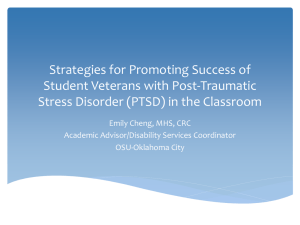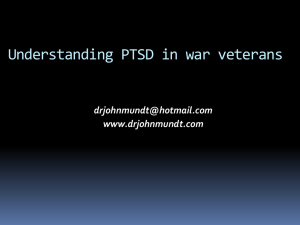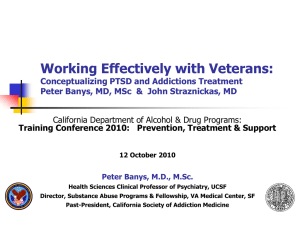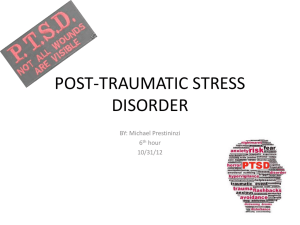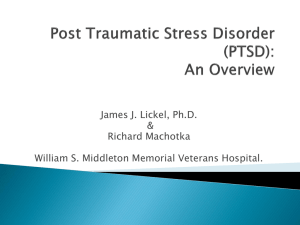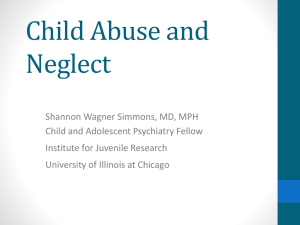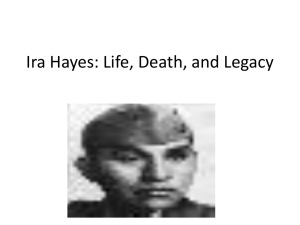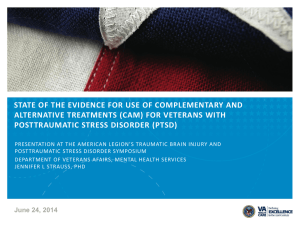here - Denver University Law Review
advertisement
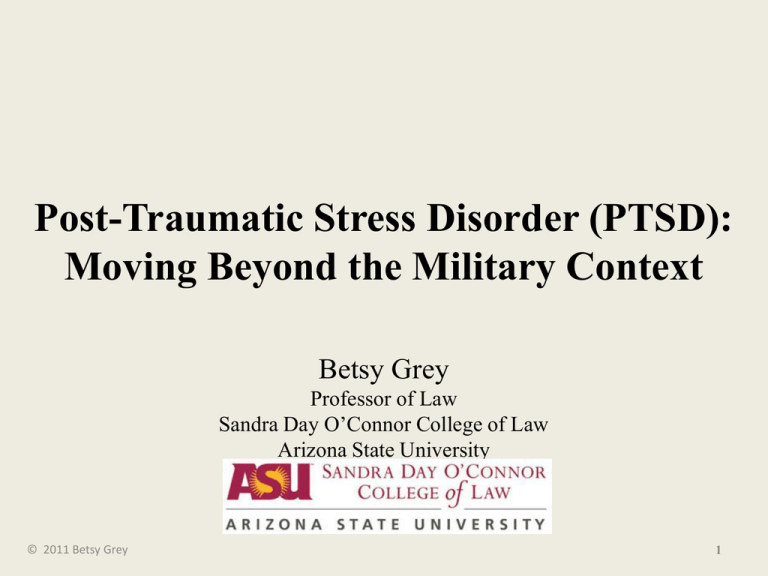
Post-Traumatic Stress Disorder (PTSD): Moving Beyond the Military Context Betsy Grey Professor of Law Sandra Day O’Connor College of Law Arizona State University © 2011 Betsy Grey 1 PTSD & Sentencing of Military Veterans Sentencing Doctrine • • • • Statutes Case Law Federal Sentencing Guidelines Veterans Courts Advances in Neuroscience Conclusion © 2011 Betsy Grey 2 State Statutes Minnesota • M.S.A. § 609.115.10 requires a presentence examination for, among other things, PTSD in Veterans. • “(b) If the defendant is currently serving in the military or is a veteran and has been diagnosed as having a mental illness by a qualified psychiatrist or clinical psychologist or physician, the court may: • (1) order that the officer preparing the report… [provide] the court with information regarding treatment options available to the defendant…; and • (2) consider the treatment recommendations… together with the treatment options available to the defendant in imposing sentence.” © 2011 Betsy Grey 3 State Statutes: California • Ca.P.C. § 1170.9 requires presentence investigation into Veteran’s mental health. • “(a) In the case of any person convicted of a criminal offense who could otherwise be sentenced to county jail or state prison and who alleges that he or she committed the offense as a result of [PTSD] stemming from service in the United States military, the court shall, prior to sentencing, make a determination as to whether the defendant was, or currently is, a member of the United States military and whether the defendant may be suffering from [PTSD] as a result of that service.” © 2011 Betsy Grey 4 Capital Cases • Porter v. McCollum (U.S. 2009) • “Our Nation has a long tradition of according leniency to veterans in recognition of their service, especially for those who fought on the front lines as Porter did.” • Specific link of PTSD to military service: – “the relevance of… combat experience… [is that] the jury might find mitigating the intense stress and mental and emotional toll that combat took on Porter.” © 2011 Betsy Grey 5 Federal Sentencing Guidelines • • • • Effective Nov. 1, 2010: Part H’s eleven specific offender characteristics: U.S.S.G. §5H1.11: “Military service may be relevant in determining whether a departure is warranted, if the military service, individually or in combination with other offender characteristics, is present to an unusual degree and distinguishes the case from the typical cases covered by the guidelines.” © 2011 Betsy Grey 6 Federal Sentencing Guidelines • Part H’s Mental and Emotional Conditions • U.S.S.G. §5H1.3: • “Mental and emotional conditions may be relevant in determining whether a departure is warranted, if such conditions, individually or in combination with other offender characteristics, are present to an unusual degree and distinguish the case from the typical cases covered by the guidelines.” © 2011 Betsy Grey 7 What is PTSD? © 2011 Betsy Grey 8 What is PTSD? PTSD is an anxiety disorder triggered by an extreme stressor, including: – – – – war combat physical and sexual abuse car accidents natural disasters & terrorism Symptoms of PTSD: – – – – flashbacks sleep disturbance numbing of emotions withdrawal © 2011 Betsy Grey 9 DSM-IV Criteria for PTSD A. Subject has been exposed to a traumatic event B. The traumatic event is persistently re-experienced in one (or more) way. C. Persistent avoidance of stimuli associated with the trauma and numbing of general responsiveness (not present before the trauma). D. Persistent symptoms of increased arousal (not present before the trauma). D. Duration of the disturbance (symptoms in Criteria B, C, and D) is more than one month. D. The disturbance causes clinically significant distress or impairment in social, occupational, or other important areas of functioning. 10 © 2011 Betsy Grey PTSD and Criminal Activity Three primary ways some individuals with PTSD engage in criminal activity: • Dissociative Reaction – believing they are in another setting / misconstruing what is occurring around them • Sensation-Seeking Syndrome – seeking a high level of dangers to compensate for lack of stimulation or thrill in everyday life • Depression-Suicide Syndrome – feelings of deep depression, hopelessness, and guilt © 2011 Betsy Grey 11 Neurobiology of PTSD © 2011 Betsy Grey 12 Neurobiology of PTSD Brain Regions Implicated in PTSD Hippocampus Amygdala Medial Prefrontal Cortex © 2011 Betsy Grey 13 Neurobiology of PTSD Neurotransmitters Implicated in PTSD Epinephrine Norepinephrine Serotonin Dopamine © 2011 Betsy Grey 14 What is neuroscience research telling about PTSD? 1. Neurophysiological changes Regional Cerebral Blood Flow in the Amygdala and Medial Prefrontal Cortex During Traumatic Imagery in Male and Female Veterans with PTSD Lisa Shin et al (2011) • Compared 17 Vietnam Veterans with PTSD to 19 Vietnam Veterans without PTSD • Used PET scanning to study regional cerebral blood flow (rCBF) during the recollection of personal traumatic and neutral events. • The PTSD group exhibited rCBF decreases in medial frontal gyrus in the traumatic vs. neutral comparison. 2. Neuroanatomical changes Thinner prefrontal cortex in veterans with PTSD Elbert Geuze et al (2008) • Examined individual cortical thickness of 25 Dutch veterans with PTSD and 25 veterans without PTSD (control group). • All participants had served in UN peacekeeping missions in Lebanon, Cambodia, or Bosnia. • The veterans with PTSD displayed reduced cortical thickness in frontal and temporal lobe, as well as poor performance on memory measures. 15 © 2011 Betsy Grey Limitations 1. What is the baseline? • How do we know the trauma is not from the crime committed rather than the previous exposure to a traumatic stimuli? 2. What is an appropriate control? • • Healthy individual never exposed to a traumatic event? Healthy individual exposed to a traumatic event but has not manifested symptoms of PTSD? 3. General limitations of neuroimaging technology • • fMRI measures changes in blood oxygenation levels; does this translate to neural activity, or one’s “mind” ? Averaging across populations. Cannot be used to diagnose individual patients © 2011 Betsy Grey 16 Conclusion • Why do we give leniency to veterans claiming PTSD as a mitigating factor in sentencing? • Other defendants claiming PTSD? Is the source of PTSD relevant? (gang violence or jail time vs. battered spouse) • Should PTSD be used as general offender characteristic or must it be linked to commission of the crime? © 2011 Betsy Grey 17 Studies investigating PTSD Military / Combat Non-Military / Combat J.J. Vasterling et al Understanding the Neuropsychological Consequences of Deployment Stress: a Public Heatlh Framework, 17 J. of Intl Neuropsychological Society, 1-6, (2011) Irina A. Strigo et al Neural Correlates of Altered Pain Response in Women with Posttraumatic Stress Disorder from Intimate Partner Violence, 68 Biol Psychiatry, 442-450, (2010). Talma Hendler et al, Sensing the invisible: differential sensitivity of visual cortex and amygdala to traumatic context, 19 NeuroImage, 587, 587-600 (2003). Bailey et al PTSD and dopaminergic genes, DRD2 and DAT, in multigenerational families exposed to the Spitak earthquake, Psychiatry Res, 507510, (2010) Benjamin L. Robinson & Sukhi S. Shergill, Imaging in posttraumatic stress disorder, 24 Current Opinion in Psychiatry, 29, 29-33 (2011). Lanieus et al Individual differences in husband and wife who developed TPSD after a motor vehicle accident: a functional MRI case study, Am J Psychiatry, 667-669, (2003) © 2011 Betsy Grey 18 Capital Cases • People v. Lucero (Ca. 1988) • Reversible error in the trial court’s exclusion of PTSD evidence, holding: “[Lucero] was entitled to have the jury consider his psychological disorder as a factor in mitigation whether or not the mental condition caused him to commit the crimes.” • Had Lucero been allowed to demonstrate his “traumatic military experience,” a jury could have found it to be a substantial mitigating factor. © 2011 Betsy Grey 19

